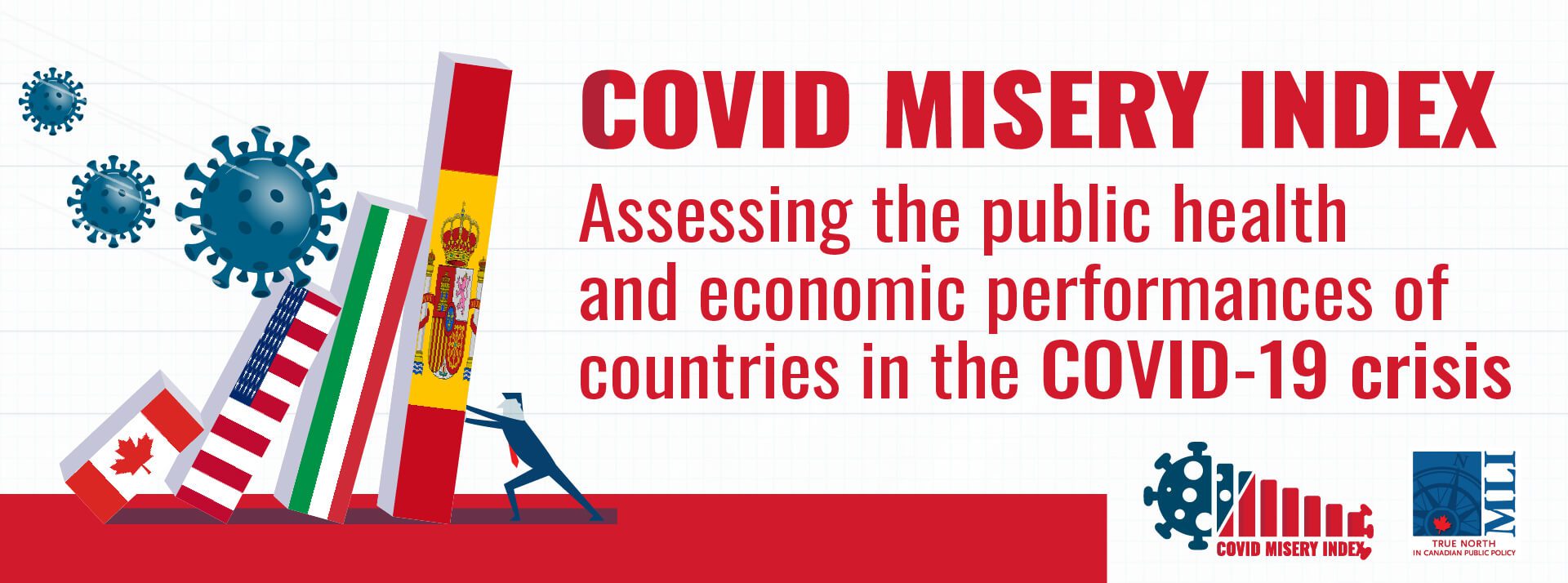View the full, updated COVID Misery Index here. Download the data for the April 14 update here. For more information, including a full methodology and analysis of the initial COVID Misery Index, click here, and view the original, non-updated Misery Index here.
To find all the MLI products related to the COVID Misery Index, click here.
What’s Happened Over the Past Week?
New variants of COVID-19 could dampen the optimism coming from the roll-out of vaccines. In Canada, although the data lags behind other countries, excess death rates remain high and the current public health restrictions will only exacerbate this.
MLI COVID Misery Index Weekly Update (April 14, 2021): The Macdonald-Laurier Institute’s COVID Misery Index is updated each week as we follow the progress of 15 developed countries to preserve the health, well-being and prosperity of their citizens during the pandemic. There are three categories: Disease Misery, a measure of the impact of sickness and death from the disease, Response Misery, a ranking of how well governments are doing on measures such as the success of vaccine rollouts or having to rely on restrictive lockdown measures, and Economic Misery, which takes into account the impact on jobs, growth and government finances.
In this update we see that over the past week Canada’s worsening ranking for Disease Misery comes primarily from the increase in deaths for people aged over 15, and especially those over 85 (indicated as Excess Deaths 15+ and 85+). While Canada has done a relatively good job at keeping the disease at bay, it has come with a heavy cost to Canadians experiencing ill-health for other reasons – especially for those 85 and over.
Further studies need to be undertaken to assess the impact of COVID-19 resulting in deaths due to delayed or interrupted treatment for other illnesses. If it can be assumed that there are fewer accidental deaths occurring because of stay-at-home orders and other restrictions on movement and activity, then the rate of excess deaths may be attributable to shortcomings in the health care system that are being exposed by the pandemic.
In terms of overall performance, Canada remains stuck in 11th place out of 15 countries ranked due to its continuing poor performance in responding to the pandemic, and severe economic fallout impacting Canadians. (For more detail about the methodology and initial results, click here.)
As of April 14, like many other countries around the world, Canada is experiencing an increase in cases. Some countries are entering a new wave of COVID-19 infections, dominated by new variants that appear to be more infectious and potentially more fatal. Many Canadian provinces are re-instituting restrictive public health measures, with Ontario’s being particularly strict.
We note that Canada’s data reporting on metrics within our Disease Misery data set is behind most other countries, and we expect that current lockdown restrictions across many provinces will result in more misery from health factors not directly attributed to COVID-19 infections in future updates. Canada’s Disease Misery for the past week receives a C+ grade and ranks 9th out of 15 countries, showing that Canada’s performance is getting worse on that measure.
Canada’s Response Misery over the past week also gets a C+ and ranks 8th out 15 countries, which is a slight improvement from the previous week. Canada’s testing regime is well above the median, indicating that we are doing a better job than most countries on our list at testing for possible cases in the community. Limiting infection relies on quick identification of cases and contact tracing for those who may have been exposed and Canada is doing well in this regard.
In addition, Canada’s vaccine roll-out is picking up steam, with its rate of getting at least a first vaccination to residents being well above average for the past week. On the negative side, the trade-off for wide distribution of the vaccine is lower rates of full vaccination as most vaccines require two doses. Most provinces are betting that the benefits from broader distribution of vaccines are greater than those of getting full vaccinations to those most vulnerable.
It remains to be seen how the incidence of blot clots related to the Oxford-AstraZeneca and Johnson & Johnson vaccines will affect the distribution rate of vaccines in Canada, as well as in the other countries in the Index. But the potential for a slow-down in vaccinations, coupled with rising case numbers, the transmission speed of the disease variants, and populations exhausted by more than a year of economic and social upheaval, may result in a more miserable summer than we hope for.
Finally, Canada’s level of Stringency measures, reflecting lockdown policies and restrictions on civil liberties, is among the highest in our group of countries, which contributes to our low grade for Response Misery. This ranking may worsen as the UK, which currently has more stringent measures in place than Canada, begins to remove restrictions in light of its successful vaccine roll-out and dramatically lowering case count.
Looking Ahead
The current increase in cases in many countries is worrying and adds urgency to the need to distribute vaccinations as widely and as quickly as possible. The light at the end of the tunnel may be further off than we hoped. In Canada, we remain particularly concerned with the elevated rates of excess deaths and the desperate need to improve access to health care for non-COVID-19 related reasons.
We will be watching Canada’s “Stringency” score, a measure of Response Misery, as new restrictions are imposed in Ontario, BC, Alberta and Quebec; this data will be included in our analysis for the next update.
Richard Audas, Faculty of Medicine, Memorial University of Newfoundland





